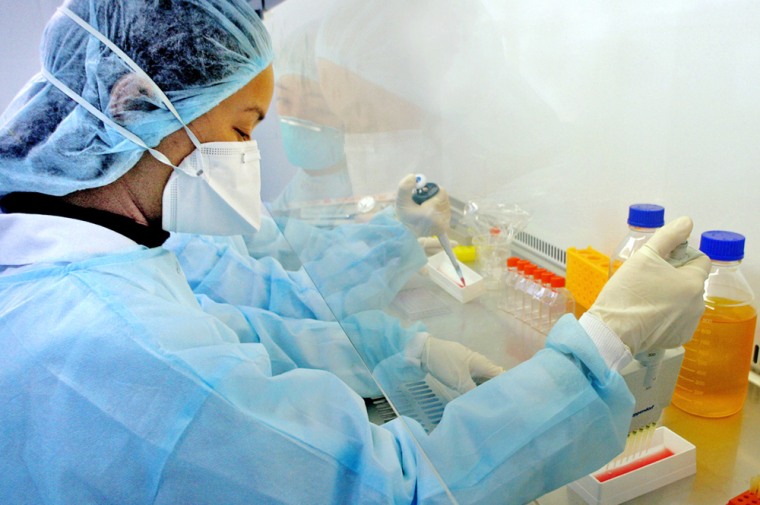Amid dire warnings of an Asian pandemic, the government is preparing to test an experimental bird flu vaccine and is increasing disease surveillance in hopes of reducing the toll from any eventual American outbreak.
Antiviral drugs are being stockpiled, and 2 million doses of vaccine are being stored in bulk form for possible emergency use and to test whether they maintain their potency.
United Nations officials warned on Wednesday that the Asian bird flu outbreak poses the “gravest possible danger” of becoming a global pandemic.
Dr. Julie Gerberding, director of the federal Centers for Disease Control and Prevention, told the National Press Club this week that “it is a worrisome situation,” though she also said the United States “is not immediately on the brink of an avian flu epidemic.”
The flu has affected poultry in eight Asian countries, with 45 human deaths among people who caught the illness, a strain of flu known as H5N1.
So far, humans appear to have caught this flu from chickens and other poultry, and the virus is not known to have spread from person to person.
Viral mutation poses global threat
What health authorities most fear is that the virus will mutate into a form that can pass easily from one human to another. That’s when a global threat would be most likely.
The deadly flu of 1918, which killed from 20 million to 50 million people worldwide, didn’t appear suddenly but mutated gradually into the deadlier form, Gerberding explained.
“That’s why it’s important to have flu vaccine and antivirals, to be ready to react when it starts to emerge,” she said.
The first doses of an experimental vaccine are almost ready for testing, antiviral drugs are being stockpiled, and the government has increased disease surveillance and expanded research programs.
The new vaccine was prepared in two different concentrations — 4,000 doses each — and is nearly ready to be shipped to the National Institute for Allergy and Infectious Diseases for clinical trials, Len Lavenda, a spokesman for the pharmaceutical firm Sanofi Pasteur, said Wednesday.
Vaccine to be tested in four states
NIAID Director Dr. Anthony Fauci said the vaccine will be tested at centers in Rochester, N.Y., St. Louis and in Maryland and Texas to make sure it is safe and to determine the correct dosage in such groups as the elderly, children and healthy young people.
In addition to the vaccine scheduled for trials, Sanofi Pasteur has produced 2 million doses of bulk avian flu vaccine, Lavenda said. The vaccine is being monitored for potency to determine if such vaccines can be produced in advance and stored until needed, he said.
Lavenda said any decision on using it if avian flu should spread would be up to the government.
Fauci said that vaccine could be available for emergency use if needed.
The 8,000 trial doses were not made under full commercial conditions, he said, so the company geared up at the same time to make 2 million doses under commercial production processes, “so that if the need arises they could rapidly scale up to tens of millions of doses.”
In a normal year more than 100 million doses of influenza vaccine are prepared for use in the United States. The inability of one manufacturer to supply its planned 48 million doses caused a shortage this year, though about 58 million doses were produced.
Because the flu changes from year to year the vaccine has to be reformulated annually.
In Europe, a program called Flupan is under way with Sanofi, European Union agencies and the University of Reading in England working on a bird flu vaccine for clinical study.
CDC spokesman Tom Skinner said that agency has a stockpile of antiviral drugs that could be used in the event of a pandemic, depending on the virus that emerges.
The disease has appeared in poultry in Cambodia, China, Indonesia, Japan, Laos, South Korea, Thailand and Vietnam.
In an effort to catch any U.S. cases early, CDC has contacted state and local health departments, hospitals and doctors, urging them to ask about recent travel by people with flu symptoms.
It called for testing patients for the bird flu if they have been in an affected area within 10 days and have confirmed pneumonia or other severe respiratory problems.
In addition, CDC said, testing should be considered for patients with a temperature greater than 100.4 who have visited such countries, visited a poultry farm and have a cough, sore threat or shortness of breath.
Major flu pandemics over the last century, according to CDC, include:
- Spanish flu that swept the world in 1918-1919 and killed an estimated 500,000 Americans. Nearly half were young, healthy adults.
- Asian flu in 1957-1958 was first identified in China. It claimed 70,000 lives in the United States.
- Hong Kong flu, 1968-1969 caused about 34,000 American deaths.
